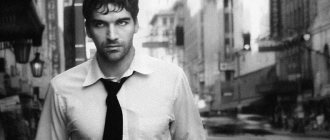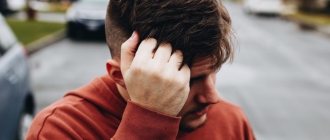Fear helped people survive in an aggressive environment and evolve. This is a normal and useful basic reaction that saves in a critical situation, encourages one to hide or escape in case of life-threatening danger, and causes a certain negative response from the body. But there is an irrational fear, not supported by anything, not related to the instinct of self-preservation, but acquired. In this case, the psyche and physiology react in the same way as in the case of real fear. This condition is called “phobia”. Among them are osmophobia and other specific fears, of which there are a huge number. Most likely, few people have heard about them, although among humanity there are quite a lot of people suffering from such phobias. This is the fear of airplanes, certain diseases, spiders and snakes, animals, holes, etc. We will talk about very rare phobias, which include the above.
Common causes of development
The appearance of persistent, unsubstantiated fear of a certain object or phenomenon is due to the following reasons:
- Childhood trauma. Events affecting the psyche in a child’s life are forgotten over time, but are deposited in the subconscious. Fear experienced a long time ago makes itself felt to an adult.
- Heredity. Fear of something can be transmitted at the genetic level from ancestors.
- Bad experience. A negative, unexpected result of an action.
- Depression, stress, exhausting the body.
- Imposed fear as a contagious phenomenon. It is transmitted from parents, whose behavior is observed by their child for a long time. This also includes the negative influence of the media, cinema, surrounding people, etc.
- Brain injuries.
- Long-term depression.
- Chronic diseases.
- Character traits.
It should be noted that the development of any phobia depends on several factors, and for each individual case they are different.
Erythrophobia - fear of blushing
Erythrophobia is a specific social phobia in which people are afraid of blushing because it tends to attract the attention of others. This begins a vicious cycle of anxiety and redness that gets worse over time. The underlying fear is social anxiety, not blushing. Cognitive behavioral therapy can help treat this phobia.
To understand erythrophobia, let's first understand why we blush. Blushing is an involuntary reaction that is triggered by our nervous system and is part of the fight or flight response. It is a complex, self-perpetuating phobia that can intensify as anxiety increases. Blushing is a response to several things, one of which is anxiety.
When we are anxious, the level of adrenaline in our body increases, which causes the blood vessels to dilate, resulting in increased blood flow. It also causes vasodilation (dilation of blood vessels) in the veins of our face, which causes redness.
Symptoms of phobias
Such disorders manifest themselves differently in everyone, depending on the individual characteristics of the person, his personality, emotional and physical state. This could be mild anxiety, a panic attack, bodily pain, etc.
The emotional sphere reacts like this:
- sudden fear develops into panic;
- the sense of reality is lost;
- there is a fear of dying;
- loss of control over the situation and oneself;
- powerlessness, inability to do something;
- the desire to escape from the source of irritation as quickly as possible.
Physiological manifestations:
- it’s hard to breathe, there’s not enough air;
- feels dizzy or has a headache;
- chills;
- dry mouth and throat;
- tremor of the limbs, their icing;
- tachycardia, arrhythmia;
- temperature increase;
- chest pain;
- nausea turning into vomiting;
- heavy sweating;
- stomach spasm;
- increase or decrease in blood pressure;
- pallor or redness of the skin.
The psyche, in turn, reacts to the subject of a phobia with unmotivated, inexplicable horror, which a person is unable to appease. Anxiety seems to paralyze the will, preventing you from doing something, calming down, concentrating and starting to think soberly. This state is completely unsettling, causing hysteria and tears.
Obsessive thoughts about the subject of fear cause tension that poisons life, interferes with the normal existence of the individual, does not give him the opportunity to visit certain places, communicate and work normally, and depletes his physical and spiritual strength. At the same time, in fact, nothing and no one threatens him.
Added to this is the following. A person subject to unmotivated fear worries and feels a sense of awkwardness that others will notice his condition, weakness and judge him. As a result, a person withdraws into himself and isolates himself.
If you take the presence of irrational fear lightly, believing that there is nothing “deadly” about it, then in the end such pathology can result in more severe mental disorders. And even suicide.
Venustrophobia - fear of beautiful women
Venustrophobia , also known as "caliginephobia" , is distinct from the fear of women (gynophobia). People who suffer from this phobia feel shortness of breath, sweating, nausea and other symptoms when they look at or are in close proximity to a beautiful woman.
Many people also experience panic attacks. Their phobia may cause them to keep their distance from people they consider beautiful. The reason for this fear is rooted in the unconscious state, where it is likely that an unfortunate event involving a beautiful woman may have occurred in the past. Different people exhibit different degrees of symptoms.
[CHOSEN FOR YOU] 17 strange and unusual alcoholic drinks
“Olfactory” problems – osmophobia
The second name for this specific disorder is olfactophobia.
This is a fear of smells and psychological hypersensitivity to them. Smells play an important role in people's lives. They are capable of causing euphoria, love (remember “Perfume” by Suskind), disgust, and expanding the perception of the world. They say that they give the strongest impetus to memories.
We can talk for a long time about how much smells mean to humans, but he received the sense of smell from nature, again for the purpose of survival. An unpleasant amber signaled the danger, for example, of some product intended for consumption. The pungent smell indicated the proximity of a predator, which also threatened our ancestors. So a certain aroma caused a gag reflex, fear, which was completely justified and life-saving.
But the osmophobe’s olfactory receptors do not respond correctly to any smell, and even his own seems disgusting to him. The individual’s nervous system becomes irritated: a feeling of fear “rolls over” him, he panics, although nothing threatens him.
This condition is usually experienced by people suffering from migraines (25% of all patients). Such an unbearable headache is precisely caused by unpleasant aromas or volatile substances.
Osmophobia can appear after tragic events that were accompanied by a certain smell. Age does not matter here: children, adolescents, and adults of both sexes are susceptible to this. In addition, individuals with hypersensitivity and melancholic people are susceptible to fear of smells.
The presence of olfactophobia may be indicated by positive answers to the following questions:
- Do odors emanating from people, objects, animals disgust you?
- Are there any scents you can't stand?
- Is the sense of smell often the cause of nausea and vomiting?
- Can smell give you a headache?
- Do you strive for loneliness due to irritability from people?
Five “yes” is a clear “bell” warning about the need to visit a doctor.
Ligyrophobia and other fears of sounds
Ligyrophobia is the fear of loud or sharp sounds. Its manifestations can be seen not only in the presence of such noise, but also in anticipation of it. The first name of the phobia comes from the Greek word “ligir” - sharp, which can be said about an unexpected high-pitched sound.
All the people flinch when they hear the loud, piercing sound and turn in the direction it came from. This is a completely normal reaction of the body to the unexpected, and the anxiety that arises instantly disappears. But this is not the case with ligirophobia.
A person suffering from such a pathology is afraid not only of loud sounds themselves, but also of the devices that produce them: alarm clocks, engines, alarms, machines, speakers. Such irritants cause psychovegetative reactions in him, extremely unpleasant sensations, although they do not pose any threat to life.
There are other similar pathologies: phonophobia is the fear of any sounds, and acoustic phobia is only certain sounds (for example, voices).
These pathologies are characteristic of young children, but can also be present in adults, and in the latter the reaction to fear is usually much more intense. Fortunately, the attack passes as soon as the stimulus disappears.
Ligyrophobes try to avoid going to places where there are, by default, many sources of sharp loud sounds: concerts, sporting events, bars, shopping centers, parks, etc. A fit of fear grips them even when expecting a sound, for example, before playing a recording on a CD. . They know for sure: at first it will be quiet, and then the music will start to sound sharply. They avoid loud-voiced people, animals (usually dogs that can suddenly bark), and children - children also usually cry unexpectedly. Such individuals are unable to use any transport (land, air, sea) and are mortally afraid of thunderstorms.
Causes of fear of sounds can be:
- very strong fear, accompanied by a sharp noise, adversely affecting the child’s psyche;
- a tragic incident, for example, a roar and clang during an accident;
- accommodation near a busy highway, airport, railway station;
- audio recordings of aggressive music (hard rock, etc.), constantly listened to by “music lovers” neighbors;
- good hearing, “sensitive” ears. Loud and sharp sounds in this case cause physical pain.
Personality traits can also contribute to the development of a phobia. It affects over-emotional, impressionable viewers of disaster films, thrillers, and horror films. In such a movie, particularly poignant moments are always emphasized by piercing sounds and music. At risk, individuals are suspicious, prone to exaggerate, unbalanced, and pessimistic.
Overwork of the nervous system as a result of chronic stress, VSD, neurasthenia, etc. also contributes to the development of phonophobia, ligiorophobia or acoustic phobia.
People with fears of sounds refuse very promising, highly paid jobs if they are sure to be noisy there. They try not to leave the house, stay in silence, limit their time “in public” as much as possible, don’t go anywhere or travel, they simply “fall out” of normal life. Of course, this is a bad solution to the problem. You can defeat a phobia only with the help of specialists and the therapeutic techniques they use.
Gamophobia - fear of marriage
Many people experience the opposite of gamophobia, called anuptaphobia, which is the fear of being alone. Gamophobia , on the other hand, is the fear of marriage, relationships, or commitment. For example, a person suffering from this phobia may fall in love with a person, but his love may change to hatred when it comes to marriage. Phobias are associated with a number of personality disorders.
Dromophobia
This is literally a fear of the path (δρόμος - path, running). This is the name for the fear of crossing a street (“agira” in Greek, so another name is agyrophobia) or a road, either a busy one or one on which no transport has ever appeared. Objects of fear include multi-lane highways, country roads, etc. And it doesn’t matter whether there is a traffic light, a pedestrian crossing, or whether you just have to run across to the other side anywhere.
A person suffering from this pathology will prefer to go to a store located 2 kilometers from home to a retail outlet located nearby, but across the road. He is driven by fear and the unpleasant sensations that accompany it.
If you believe that the cause of such fear was the participation of such an individual in an accident or observation from the side of a car accident with other people, then this does not happen in every case. Although experts say that this is not impossible, add to this the loss of a loved one in an accident or watching the news with terrible images of tragic road accidents. They also believe that agyrophobia develops due to the individual’s emotional arousal from the above, fear of getting hit by a car, due to lack of self-confidence.
But more often than not this is not the case. Dromophobes are unable to explain why such fear arises. They are quite adequate, have rational thinking, but in this case they cannot say what exactly they are so afraid of. Understanding perfectly the absurdity of what is happening, these people are not able to overcome their phobia.
It should be borne in mind that if people with poor vision are afraid to cross the road, then they cannot be classified as agyrophobics - they have a precise reasoning for their fear.
By the way, dromophobe can calmly walk along the highway that frightens him. He can even cross it through an underground passage, as well as through a crowd of people or accompanied by another person, but only if he was the first to step onto the road. In this case, the agyrophobe believes that these people or the companion are in control of the situation.
Chronophobia - fear of time or the movement of time
Chronophobia is a specific psychological phobia that is a fear of time, or the passage of time. Chronophobes feel that the present moment may soon become the past, and it passes very quickly. They may feel like they haven't done enough in life and time flies.
The phobia, which can be genetic, can be caused by depression. Fear is mainly experienced by older people and people who are in one place or trapped without the opportunity to go outside (for example, in prison). A phobia can occur in people who are in a state of heightened anxiety.
Nephophobia
Nephophobe is afraid of clouds. In clear weather, such a person can still look at the clear sky, but as soon as the slightest clouds or clouds appear on it, he can only look at his feet. Nephophobes see monsters and monsters in bizarre forms, ready to attack them at any moment. A cloud seen by chance in a picture or film causes a panic attack with a rapid heartbeat and trembling hands.
Ephebiphobia - fear of teenagers or young people
First coined as "fear of teenagers" and now "ephebiphobia", is a term used to describe fear and aversion towards teenagers. Sociologist Ray Oldenburg links this fear to the generation gap in society.
This fear is not new; it was described by Machiavelli. This phobia is caused by external events and internal predispositions in a person’s life, combined with genetics, heredity, brain chemistry and life experiences. The assumption that teenagers are inherently dangerous, full of imbalanced hormones and uncontrollable, gives rise to a modern form of this very old phobia.
[CHOSEN FOR YOU] The strangest gadgets presented at CES 2019
According to Kirk Astrot, a professor of family and consumer sciences at the University of Arizona in the US, Americans began to fear teenagers and their behavior in the late 1980s. Astrotus also coined the name for the phobia from the Greek word ephebe, which means "a teenage boy who is isolated from society at age 17 to learn to survive on his own and fight." The boy later returned to society and protected the city, but was feared at the same time.
Somniphobia - fear of sleep
This unusual phobia has been observed to be more common in children than in adults. Fear of sleep can be caused by fear of nightmares or other things that only happen to a person when he is sleeping or suddenly waking up.
Fear of sleep can also be caused by sleep paralysis, anxiety, waking up suddenly at night, or anything that makes a person afraid to go to bed. Somniphobia and insomnia are two different things . One is fear of sleep and the other is inability to sleep.
Hexakosioyhexekontahexaphobia - fear of the number 666
An attack of this disease was shown in the episode "The Honking" of the animated series Futurama. Then Bender was afraid of the reflection in the mirror of the reflected symbols “0101100101” (666 in the binary number system).
There are several known cases where transport route numbers were changed to a different number to avoid it.
Optophobia - fear of opening eyes
For optophobic people, simply opening their eyes can feel like a nightmare. They are afraid of the “what if” consequences if they open their eyes and look. Fear can be situational. For example, many of us are afraid to open our eyes while watching a horror movie.
There are times when fear is not situational, but long-lasting. People may lock themselves in a dark room or keep their eyes closed for fear of seeing something that might cause them stress or trauma. When they see something they don't like, they may exhibit several symptoms typical of phobias.
Plutophobia - fear of wealth or money
A rare phobia, because people dealing with flesh phobia may be afraid not only of wealth or money, but also of wealthy people. They may think that rich people are “greedy” and “untrustworthy.” They may also be afraid of becoming rich themselves. Plutophobic people may deliberately sabotage their careers to avoid making a lot of money.
This fear may be because people are worried about the pressure that can come with wealth. They may think that their family and friends will force them to help them or that they themselves will take advantage of other people if they become rich.
Plutophobia can also arise from a desire to "protect themselves", believing that wealth will make them more vulnerable to looters and thieves.
Arakibutyrophobia
The most unusual phobia that can cause healthy bewilderment is the fear of peanut butter, or rather, that it will stick to the tongue, palate and then suffocation will occur. Of course, you can solve the problem simply: never buy this product, but people obsessed with arakibutyrophobia claim that one type of sweetness makes them break out in a cold sweat and shake like a leaf. The phobia is considered quite rare.
The list of phobias that seem ridiculous can be continued for a long time - there are many things in the world that some people are neutral about, while others are truly horrified by them. Often those suffering from atypical fears may not even suspect that this is a real phobia - they are so incredible. However, even such strange fears can and should be fought: the main thing is to recognize the problem in time.
Siderophobia - fear of the stars in the sky
A very peculiar fear, siderophobes would not like to go out at night and cannot stand looking at the starry sky. They usually close the windows and draw the curtains at night to avoid catching a glimpse of the night sky. If they see stars, they may faint or exhibit several other symptoms of a phobia such as nausea, sweating, shortness of breath, panic attacks.
As with other phobias, siderophobia can develop due to a combination of several factors affecting the person. They may have experienced a traumatic event where they saw stars and began to associate stars with stress and fear.
Vestiphobia - fear of clothes
Westiphobes would not like to wear any clothes at all, or dress minimally. Wearing clothes, especially tight ones, can make a vestiphobe feel claustrophobic and uncomfortable. People who are allergic to various tissues may also develop vestophobia. Vestiphobia can also be a fear of certain clothes, such as trousers.
Xenophobia - fear of foreigners or strangers
It is common knowledge that Stephen Hawking was afraid of aliens. In 2012, he warned people that aliens could be roaming space and looking for planets to colonize and resources to plunder. Xenophobia can be the fear of any stranger or foreigner, or, as it was with Hawking, alien beings.
Webster's Dictionary defines "phobia" as "fear of the unfamiliar." This fear is present in many people, and some of the first instances of xenophobic sentiments were seen by the ancient Greeks. Xenophobia can also be a fear of loss of national, ethnic or racial identity.
Selfiphobia
The fear of a bad selfie occupies a special place in the unusual list of phobias. A person who takes 100+ variations of the same photo until he gets the perfect result is not just a bore, he may be obsessed with selfiephobia. If this seems like complete nonsense to an ordinary person, then doctors recognize this illness as a serious mental disorder that can lead to dire consequences and even suicide attempts.








